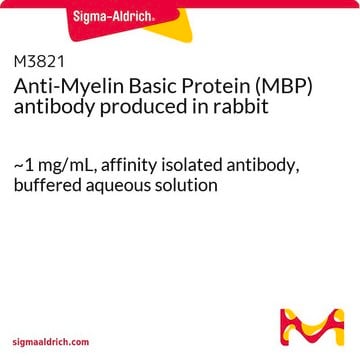N2912
Anti-Neurofilament 160/200 antibody, Mouse monoclonal
~2 mg/mL, clone RMdO20, purified from hybridoma cell culture
Sinónimos:
Anti-NEF3
Seleccione un Tamaño
$515.00
Disponible para envío el31 de marzo de 2025Detalles
Seleccione un Tamaño
About This Item
$515.00
Disponible para envío el31 de marzo de 2025Detalles
Productos recomendados
origen biológico
mouse
Nivel de calidad
conjugado
unconjugated
forma del anticuerpo
purified from hybridoma cell culture
tipo de anticuerpo
primary antibodies
clon
RMdO20, monoclonal
Formulario
buffered aqueous solution
reactividad de especies
mouse, rat, human
concentración
~2 mg/mL
técnicas
immunocytochemistry: suitable
immunohistochemistry: suitable
microarray: suitable
western blot: 1-2 μg/mL using extracts of rat brain S1 fraction.
isotipo
IgG1
Nº de acceso UniProt
Condiciones de envío
dry ice
temp. de almacenamiento
−20°C
modificación del objetivo postraduccional
unmodified
Información sobre el gen
human ... NEFH(4744) , NEFM(4741)
mouse ... Nefh(380684) , Nefm(18040)
rat ... Nefh(24587) , Nefm(24588)
Descripción general
Inmunógeno
Aplicación
Immunohistochemistry (1 paper)
Western Blotting (1 paper)
Forma física
Cláusula de descargo de responsabilidad
¿No encuentra el producto adecuado?
Pruebe nuestro Herramienta de selección de productos.
Opcional
Código de clase de almacenamiento
10 - Combustible liquids
Clase de riesgo para el agua (WGK)
WGK 3
Punto de inflamabilidad (°F)
Not applicable
Punto de inflamabilidad (°C)
Not applicable
Equipo de protección personal
Eyeshields, Gloves, multi-purpose combination respirator cartridge (US)
Elija entre una de las versiones más recientes:
Certificados de análisis (COA)
¿No ve la versión correcta?
Si necesita una versión concreta, puede buscar un certificado específico por el número de lote.
¿Ya tiene este producto?
Encuentre la documentación para los productos que ha comprado recientemente en la Biblioteca de documentos.
Los clientes también vieron
Active Filters
Nuestro equipo de científicos tiene experiencia en todas las áreas de investigación: Ciencias de la vida, Ciencia de los materiales, Síntesis química, Cromatografía, Analítica y muchas otras.
Póngase en contacto con el Servicio técnico







